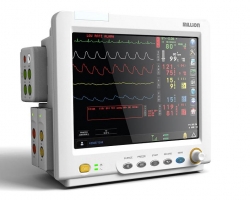Wechat QR code

TEL:400-654-1200

TEL:400-654-1200

1. What are the differences between ECG monitor 3 lead and 5 lead ECG lead?
Monitor manufacturers summarize the role of the ECG monitor
The 3-lead ECG lead can only obtain the I, II, III lead ECG, and the 5-lead ECG lead can obtain the I, II, III, AVR, AVF, AVL, V lead ECG.
In order to facilitate the quick connection, we use the color labeling method to quickly stick the electrodes in the corresponding orientation. The 3-lead ECG wire is marked with red, yellow, green or white, black and red. The 5-lead ECG wire is marked with white, black, red, green, and synthetic colors.
Second, why ECG monitoring advocates wearing blood oxygen saturation first?
Because wearing blood oxygen saturation sets is much faster than connecting ECG lead wires, the patient's pulse rate and blood oxygen saturation can be monitored in the shortest possible time, and the medical staff can quickly evaluate the patient's most basic signs.
Third, the blood oxygen saturation finger sleeve and the sphygmomanometer cuff can be placed in the same body?
Measuring blood pressure will block the arterial blood flow, and then lead to inaccurate oxygen saturation monitoring during blood pressure measurement. Therefore, it is clinically not recommended that the blood oxygen saturation cuff and the active blood pressure monitor cuff be on the same side of the limb.
Fourth, why often use ECG monitor II lead ECG waveform? Due to the II lead electrocardiogram, the waveform is most pronounced. When recording electrocardiograms beside the bedside, in addition to the conventional 12-lead synchronization record, a separate II lead record strip should be kept, mainly for comparative analysis, which is conducive to the analysis of various arrhythmia. ECG monitor commonly used models

5. Will patients with ECG monitoring replace electrode pads?
Demand replacement, due to the electrode pads stuck to the same part of the time too long, it will lead to skin rashes, blisters attack, so you should always check the skin condition, even now the skin is intact, replace the electrode pads and adhesive sites 2-3 days to avoid The onset of skin damage in the patient.
Six, non-invasive blood pressure monitoring what should pay attention to it?
(1) Avoid blood pressure monitoring of limbs in internal limb paraplegia, hemiparalysis limbs, ipsilateral limbs of patients undergoing resection of breast cancer, infusion limbs, edema and hematoma skin damage, and attention should be paid to poor coagulation function and sickle cell disease Patients, to avoid the occurrence of medical disputes due to blood pressure measurement.
(2) The measurement part should be replaced by the practice, and the expert claims to replace it every 4 hours. Avoid measuring on one limb, resulting in purpura, ischemia, and nerve damage in the limbs that collide with the cuff.
(3) When measuring adults, children, and newborns, pay attention to the choice of cuffs and pressure values, because the pressure exerted on adults is used to protect children and newborns. When the instrument is set in the newborn, the adult's blood pressure cannot be measured.
Monitor manufacturers
Seventh, blood oxygen saturation monitoring what attention?
The most commonly used site for blood oxygen saturation monitoring is the index finger, and earlobe, nose, and forehead areas can also be used. The fingertips should be cleaned as much as possible with one person, one for every one to replace the parts every 1-2 hours, to avoid the onset of cyanosis, redness, and pressure sores caused by blood circulation at the fingertips (especially in patients with fainting and impaired limb movements)
VIII. There is no monitoring module on the monitor. How is the breathing monitored? The breath on the monitor is based on the electrocardiogram electrodes to sense changes in the impedance of the thorax and to show the waveform and data of the breath.
Nine, all parameters have alarm scale, how to set?
Alarm criteria: to ensure the safety of patients, to minimize noise interference, do not allow the closure of the alarm function, the setting of the alarm scale is not a normal scale, but should be the scale of safety.
Alarm parameters: heart rate 30% above and below the physical and mental rate; blood pressure according to doctor's advice, the patient's condition and the setting of the root; oxygen saturation is set according to the condition; alarm volume must be heard within the scope of the nurse's work; alarm scale should be adjusted according to the situation at any time, At least once per class.
X. The patient's heart rate is 56 beats/min. Can the ECG monitor be set in accordance with the alarm parameters? No, although the heart rate scale should be set at 30% above and below the physical and mental rate, the heart rate of 56 times is now slow. If the heart rate alarm limit is set at 40 times, it is no longer a safe scale. Therefore, the scale of the alarm should also be adjusted at any time according to the situation to ensure the safety of the patient.